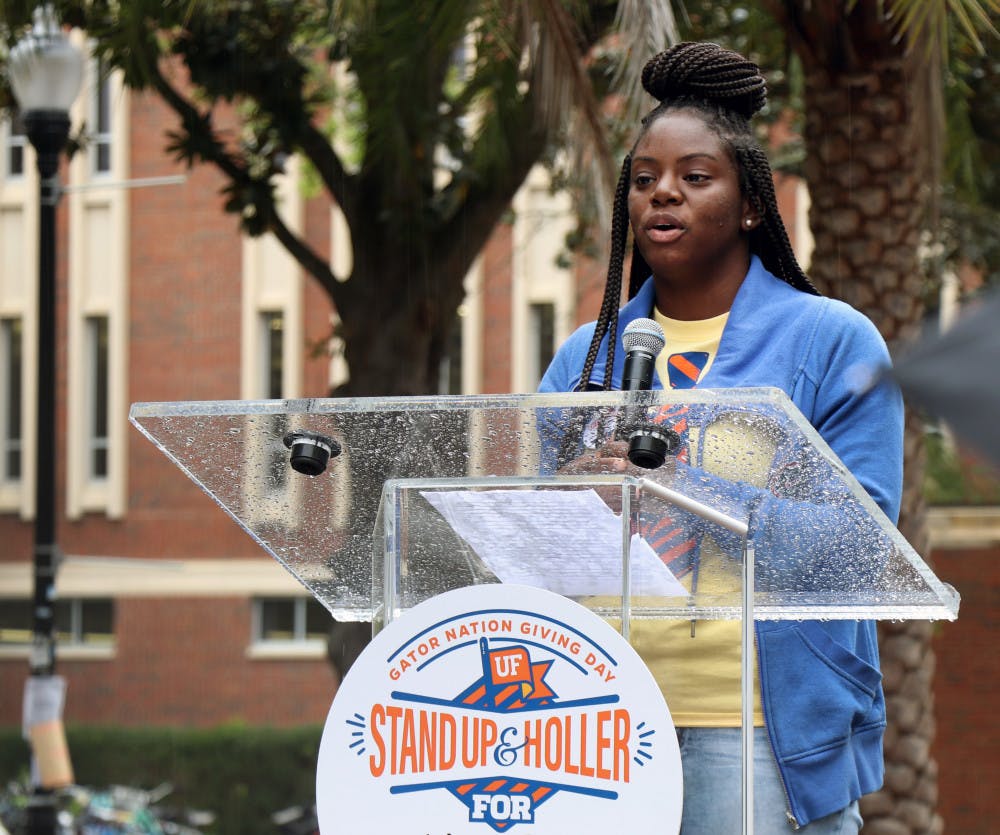All across campus, Mr. Two-Bits ties were plastered over the red brick exterior of campus buildings. The iconic accessory is easily recognized and hard to miss.
The timely campaign featuring the orange and blue striped banners of the late George Edmonson’s tie showcased UF’s second annual Giving Day. In its second year, more than $23 million was raised for UF colleges, programs and clubs. It doubled last year’s amount from $12.6 million, the first year of the fundraising event.
Giving Day is a 24-hour fundraising effort spearheaded by the UF Alumni Association in conjunction with the UF Foundation, which, according to its website, is the “fundraising and gift fund management arm of the University of Florida.” Together, they strive to inform donors with decorations like Mr. Two-Bits’ ties, Gator Day at the Florida capitol building in Tallahassee and various on-campus booths and activities.
According to Giving Day’s website, the main purpose behind the event — which started at midnight Thursday and ended that same day at 11:59 p.m. — is to increase alumni donations in support of “UF’s far-reaching work and our drive to the Top 5 of public universities.”
Despite these efforts, some students didn’t entirely know what the event was.
Ethan Lay, a 21-year-old UF art history junior, “kind of” had an idea as to what Giving Day was, saying he thought it had something to do with donations to the school.
“Tuition is expensive,” Lay said. “I already give the school money, so students giving more money is an interesting question.”
Luke Anderson, the UF Foundation spokesperson, explained that advertising Giving Day on campus was strictly to show students that they have a strong network of alumni supporting them in their collegiate efforts.
When asked how she felt about Giving Day, Isha Verma, an 18-year-old UF biomedical engineering freshman, explained that she feels conflicted about the idea of UF asking students for money.
“We’re already paying so much to the university, but I also do understand because I was at Marston today and they were asking for money to help other students get textbooks,” Verma said. ”I see that as a good cause, but then I’m also like, doesn’t my tuition and state funding cover this?”
After receiving more than 11,000 donations in that time span last year, the university’s 2020 goal was set at 15,000 donations in one day. It received 16,772 donations. Currently, UF is tied for No. 7 in the US News & World Report rankings of top public universities. In order to break through the top five, the university decided to focus on increasing alumni giving.
But according to how the US News & World Report ranks universities, alumni giving is tied for the category with the smallest weight. The other tied category is social mobility. Alumni giving only makes up 5 percent of what goes into a school’s national standing. Other factors include graduation and retention rates at 22 percent, undergraduate academic reputation at 20 percent, faculty resources at 20 percent and others.
Alumni giving is defined by US News and World Report as “the nonweighted mean percentage of undergraduate alumni of record who donated money to the college or university.”
This figure is used as a measuring stick for student satisfaction with a university. If students enjoyed their time in school, they are more likely to donate money to their alma mater, according to the report.
Other universities ranked in the top 10 hold their own versions of giving days throughout the year. No. 2 University of California, Berkeley, has Big Give on March 12, which its website describes as their annual 24-hour “fundraising blitz.” No. 3 University of Michigan held its most recent Giving Blueday on Dec. 3.
According to Anderson, the organization uses “many of these (merchandise, banners, etc.) items year-over-year to save costs.” However, there are costs — like food and a D.J. at IBC and La Casita on Thursday — that cannot be reused or paid for once.
When asked about how much was spent on advertising for Giving Day this year, Anderson said that the organization did “not have budget numbers.”
In its 2018 990 tax return — before the first Giving Day — the UF Foundation reported $13.38 million in total fundraising expenses and revenue of $3.6 million.
Contact Payton Titus at ptitus@alligator.org. Follow her on Twitter @petitus25.
Akiya Parks, a first-generation student and Machen Florida Opportunity Scholar, addresses the crowd on the Plaza of the Americas Feb. 26, 2019, for the “Stand Up and Holler: Gator Nation Giving Day.”

Payton is a sophomore journalism major from Jacksonville, Florida. She is The Alligator's Spring 2021 digital managing editor. Her previous roles include softball beat writer, football beat writer and online sports editor.






